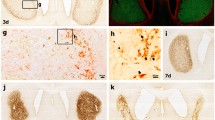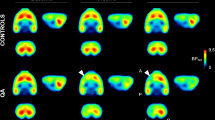Abstract.
Intracerebral infusion of 3-hydroxyanthranilate (3HANA) rapidly increases the brain content of the endogenous excitotoxin quinolinate (QUIN). QUIN formation from 3HANA is readily prevented by coadministration of the specific 3-hydroxyanthranilate oxygenase inhibitor 4-chloro-3HANA (4-Cl-3HANA). This experimental paradigm was used to identify the cell populations which are responsible for the rapid de novo production of QUIN in the rat striatum in vivo. Rats received an intrastriatal infusion of 3HANA, alone or together with equimolar 4-Cl-3HANA, for 1 h. Striatal QUIN immunoreactivity (ir) was assessed immunohistochemically, using an antibody against protein-conjugated QUIN. This antibody displayed no significant crossreactivity with compounds structurally or functionally related to QUIN. QUIN-ir cells were detected after infusion with ≥300 µM 3HANA, but not in naïve striata or after co-infusion of 4-Cl-3HANA. Cellular staining was also abolished by preabsorption of the antibody with protein-conjugated QUIN. In the normal striatum, QUIN-ir was detected exclusively in cells of an apparent microglial morphology. When examined in the excitotoxically lesioned striatum, 3HANA-induced QUIN-ir localized exclusively to OX42-ir cells of an activated microglial/macrophage morphology. These data indicate that microglia and macrophages are the major source of QUIN in the rat striatum when hyperphysiological concentrations of 3HANA are used to drive QUIN synthesis. Comparison with earlier biochemical and immunohistochemical studies suggests that the enzyme responsible for microglial QUIN production is a distinct 3-hydroxyanthranilate oxygenase with high capacity and low affinity for 3HANA.
Similar content being viewed by others
Author information
Authors and Affiliations
Additional information
Electronic Publication
Rights and permissions
About this article
Cite this article
Lehrmann, E., Molinari, A., Speciale, C. et al. Immunohistochemical visualization of newly formed quinolinate in the normal and excitotoxically lesioned rat striatum. Exp Brain Res 141, 389–397 (2001). https://doi.org/10.1007/s002210100887
Received:
Accepted:
Issue Date:
DOI: https://doi.org/10.1007/s002210100887




